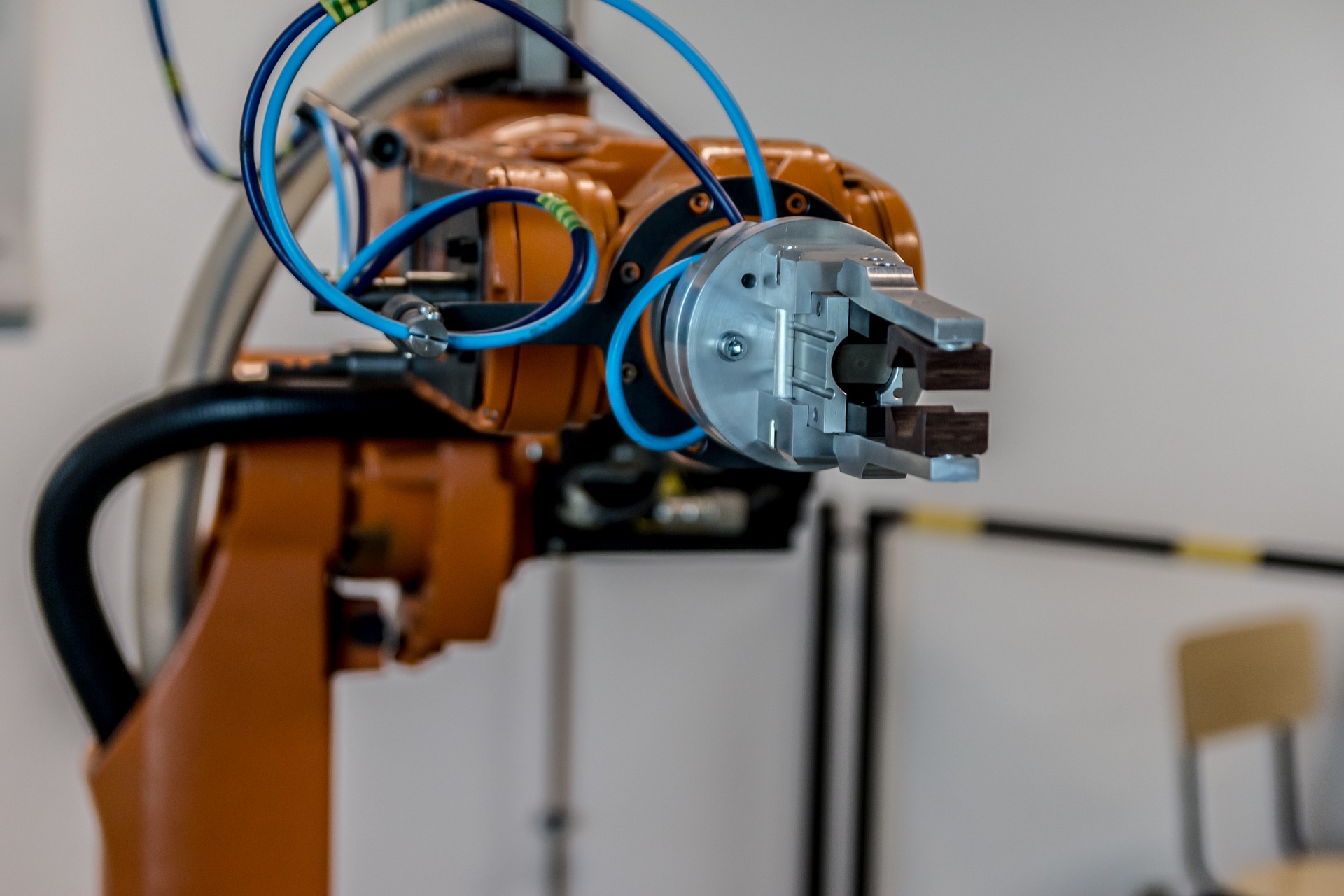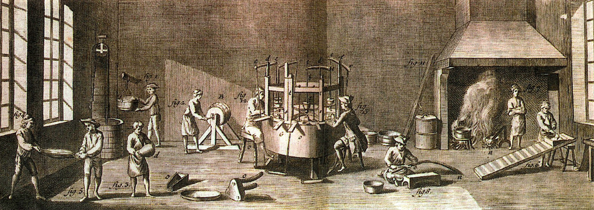Capital goods suppliers, such as the machining-tool industry, produce industrial equipment such as milling machines, grinders and lathes, that are bought by mass-manufacturing firms. It is the capital goods, combined with particular production technologies, such as interchangeable parts and the production-line system (as-well as organisational innovations) that have transformed production into mass-production. According to (Rosenberg, 1982) most of the technological innovation of the past two centuries have occurred within the capital goods industry.
As Adam Smith explains, in the Wealth of Nations, with his famous example of the pin factory, there has been a continuous, progressive division of labour during and since the industrial revolution. Division of labour is essentially, breaking-down the manufacturing process into its' component parts, and applying machinery (Capital Goods) - mechanisation, and logistical management, to assist in the productivity of each process.
Through the division of labour, there is another dynamic which occurs, which is specialisation. Specialisation increases, as a worker develops greater knowledge of their particular job, as they spend more time doing it. Today, specialisation has evolved from ‘learning by doing and using' within the factory, to also much of the higher-education and vocational training system external to industry; and so now a majority of people entering the workplace have a minimum of specific skills in specific disciplines, such as marketing, accounting, computer literacy, or production management for example.
It is exactly the development in the division of labour and specialisation that has been the underpinning for the development of the modern supply chain. As each process becomes more and more specialised, entrepreneurs have taken the opportunity to specialise in specific parts of an industrial process or good - making metal springs for example; that they can then offer as a product or service as an independent company, to different companies, across different industries, in the case of the metal spring. They can then increase their productivity through ever increasing specialisation and through the introduction of mass-production technologies, and combined with the dynamic returns-to-scale (as they have a larger potential market), these companies can now produce the specific part within the supply chain at a fraction of the cost that the original company could just for itself. This process has spread from intermediate components, to services such as accounting, and IT for example.
This process has been described as:
“…a vertical splintering of industry [leading to] each [sequential] layer produc[ing] an intermediate product which becomes an input to the next stage in the production process.” (Argyrous, 2011).
In essence, there are now a vast array and number of 'vertically specialised' companies that are positioned between the lead company and the raw materials. And it is this trade along the upstream supply chain that dominants international trade, and it is estimated that "about 50 percent of the value of international trade in goods and services is in intermediate rather than in final goods and services" (Milberg et al, 2013).
As manufacturing industries have increased in their 'vertically splintering' during the last 20 years or so, the types of firms and their scope of activity within the value chain has changed.

The 'original' mass-production firm was predominately an Integrated Firm. Now, often referred to as the old style of manufacturing (or even a 'dinosaur'), many of these firms went through a process of selling, spinning-off, or closing, some of their vertical activities (such as component manufacturing divisions and/or subsidiaries, and business services like IT for example), and then, contracting or subcontracting these from suppliers.
These Integrated Firms are then transformed into what is called a Lead Firm, which is described in a moment. Examples of Integrated Firms include “old” Ford Motor Company, “old” IBM Corporation, perhaps still Koninklijke Philips N.V, and (at least in 2011) a Chinese company like BYD Auto Co., Ltd for example, that manufacturers/ed nearly all its own components (Day, 2011). Tesla Energy’s ‘Gigafactory’, a battery factory (cell production estimated for commencement in 2017), is a modern-day example of an integrated firm both in a developed country and in the growing area of electric energy storage (linked to growth - and projected growth - in electric transport, mobile technologies, renewable energies). This latest example actual shows a potential reverse in the trend.
Mass-production firms go through (and in many case, continue to go through) this process, for a few reasons: perhaps the sourced good or service is cheaper and/or higher quality than they can make it themselves, or it is a way to free-up cash for investment it in other things. The way in which these contracted companies can make things cheaper, through specialisation, and economies-of-scale is briefly mentioned above, but this only focuses on the micro level. At the macro level, many of these contracted companies potentially also have access to cheaper input costs (access to a large skilled, or cheap low-skilled, labour force for example - as in China and India for example) and cheaper credit, through a difference in domestic laws and norms, and government policy (including, in some cases exchange rates). And this is, in part, made possible by the revolutions in the internet and digital communications, supporting the management of downstream supply chain logistics and the monitoring of inventory for instance; and a global financial system with global financial standards.
This mass-production 'group' of actors are now vertically integrated and specialised in the value chain. And the head of the downstream supply chain, like the Integrated Firm, is the Lead Firm. Also similar to Integrated Firms, Lead Firms also initiate the flow of resources and information through the value chain with the direction of production, and marketing of final goods. They differ, however, from Integrated Firms in that they focus on their ‘core competences’ and 'high value added functions', such as branding, marketing, finance, product strategy and definition, design, assembly of sourced components, and even sales (like Apple Inc. and Dell Inc. for example). And in some cases like Dell, these lead firms have become FABless - they do virtually no manufacturing or assembling themselves anymore.
Increasingly, over the last 10 years, many lead firms have consolidated this vast base of sourced intermediate good suppliers, with examples of lead firms reducing supplier numbers from a thousand to a few hundred (Harrison 2008). In this situation, the old suppliers (i.e. component manufacturers) often remain in the value chain, but now they are contracted via a new group of specialised firms called Turn-key Suppliers, examples include Dana, Delphi, Celestica, and Foxconn; huge companies, relatively unheard of by final consumers/users. And these Suppliers are in some cases ‘single-source’ strategies, in the case of Foxconn, that are contracted by Apple Inc, to assembly it's iPhone. In this example, Foxconn manages all the logistics of the downstream supply chain for the iPhone (Milberg, 2013).

Below the Turn-Key Supplier in the map, are the intermediate goods manufacturers. Again, this often has some hierarchal structure, as component manufacturers have in many cases, also 'vertically splintered', and outsourced parts of the production process can be contracted somewhere else cheaper. And so this hierarchy often goes down, to the companies that are producing the simplest 'widget', at the cheapest possible price. Important to note that the bottom of this hierarchy is, unsurprisingly, predominantly manufacturers in developing countries.

